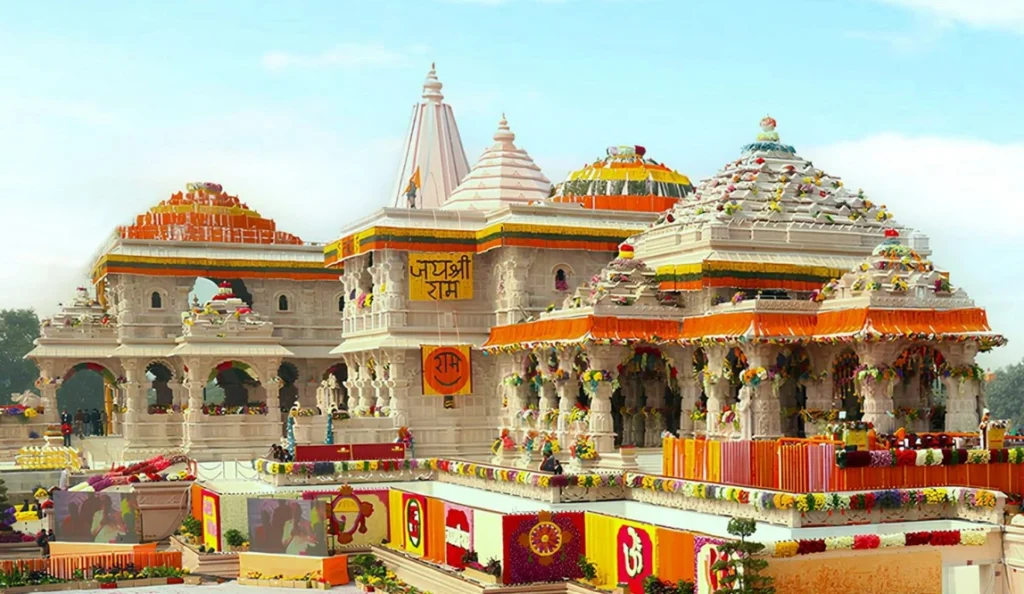Discover Ayodhya District, the sacred land of Lord Ram. Explore its ancient temples, rich history, spiritual legacy, and vibrant cultural heritage in Uttar Pradesh.

Explore Ayodhya: Temples, History & Spiritual Legacy
Ayodhya, a district located in the northern state of Uttar Pradesh, India, is a place of immense historical, cultural, and religious significance. Known as the birthplace of Lord Rama, Ayodhya has been a focal point of Hindu spirituality for centuries. With its rich history, diverse heritage, and vibrant atmosphere, Ayodhya attracts pilgrims, tourists, and historians alike.
Historical Significance:
Ayodhya’s history is intertwined with the epic Ramayana, an ancient Indian epic that narrates the life and adventures of Lord Rama. According to the Ramayana, Ayodhya was the capital of the legendary Kosala Kingdom and the birthplace of Lord Rama, an incarnation of Lord Vishnu. The district’s historical importance is further solidified by the presence of many ancient temples, ghats, and ruins that hold stories of a bygone era.
Religious Heritage:
Ayodhya is a place of great religious significance for Hindus. The Ram Janmabhoomi temple, dedicated to Lord Rama, has been a focal point of devotion for generations. The temple is located at the exact spot believed to be the birthplace of Lord Rama. The construction and restoration of this temple have been a subject of debates and discussions, making it not just a place of worship but also a symbol of cultural identity.
Cultural Diversity:
The district’s cultural diversity is an amalgamation of various influences. While Ayodhya is predominantly known for its Hindu heritage, it also houses religious sites for Buddhism, Islam, and Jainism. The Hanuman Garhi temple, devoted to Lord Hanuman, is another popular religious site in the district. The vibrant festivals, including Diwali, Ram Navami, and Hanuman Jayanti, bring the district to life with colors, lights, and fervent celebrations.
Tourist Attractions:
Apart from its religious significance, Ayodhya boasts a range of attractions that appeal to history enthusiasts and tourists. The Ramkatha Museum showcases artifacts, sculptures, and depictions of the epic Ramayana, providing a comprehensive overview of the story’s influence on art and culture. The Tulsi Smarak Bhawan, dedicated to the famous saint-poet Goswami Tulsidas, offers insights into his life and works.
Promotion of Tourism:
Recognizing the potential of Ayodhya as a tourist destination, efforts have been made to enhance infrastructure and facilities. The district’s accessibility has improved over the years, making it easier for tourists to visit and explore the region. Additionally, cultural and religious events are organized to engage visitors and showcase the district’s rich heritage.
Challenges and Opportunities:
While Ayodhya holds immense cultural and historical value, there are challenges that need to be addressed for sustainable development. Preservation of heritage sites, managing the influx of tourists, and maintaining the balance between modernization and cultural sensitivity are crucial aspects that require attention.
Famous Places in Ayodhya District
Ayodhya District is home to several famous places that hold deep historical, religious, and cultural significance. Here are some of the notable attractions:
Ram Janmabhoomi Temple: The most renowned site in Ayodhya, this temple marks the birthplace of Lord Rama. A symbol of devotion for millions, it attracts pilgrims from all over India and beyond.
Hanuman Garhi: A temple dedicated to Lord Hanuman, known for its unique architecture and its religious importance. It offers panoramic views of Ayodhya and is a popular spot for devotees and tourists alike.
Tulsi Smarak Bhawan: Dedicated to the poet-saint Goswami Tulsidas, this memorial showcases his life and works. It’s a serene place to reflect on his contributions to literature and spirituality.
Ramkatha Museum: This museum narrates the epic Ramayana through sculptures, paintings, and artifacts. It provides insights into how the story has influenced art and culture over the centuries.
Swarg Dwar: Also known as “Gateway to Heaven,” this site is believed to be where Lord Rama left for his heavenly abode. Devotees often visit to pay their respects and seek blessings.
Kanak Bhawan: This temple is dedicated to Lord Rama and Sita and is known for its stunning gold-plated interiors. It’s a significant site for devotees and those interested in religious art.
Nageshwarnath Temple: This ancient temple is dedicated to Lord Shiva and is considered one of the oldest places of worship in Ayodhya. It’s a site of religious importance for both Hindus and Jains.
Sita Rasoi: A kitchen area believed to be used by Goddess Sita during her stay in Ayodhya. The site has symbolic significance and is visited by many devotees.
Gulab Bari: A mausoleum dedicated to Nawab Shuja-ud-Daula, this architectural gem is surrounded by beautiful gardens and is a serene place to visit.
Moti Mahal: A historical structure with Mughal architecture, it was once the residence of Rani Urmila, one of Lord Rama’s sisters. The intricate design and history make it a captivating visit.
Ram Ki Paidi: A series of ghats along the Sarayu River, this area is used for religious rituals and ceremonies. It’s a tranquil spot for reflection and prayer.
These famous places in Ayodhya District offer a glimpse into the district’s rich heritage, spiritual significance, and historical importance. Whether you’re a pilgrim, a history enthusiast, or simply seeking a place of serenity, Ayodhya has something unique to offer to every visitor.
Read More :-
